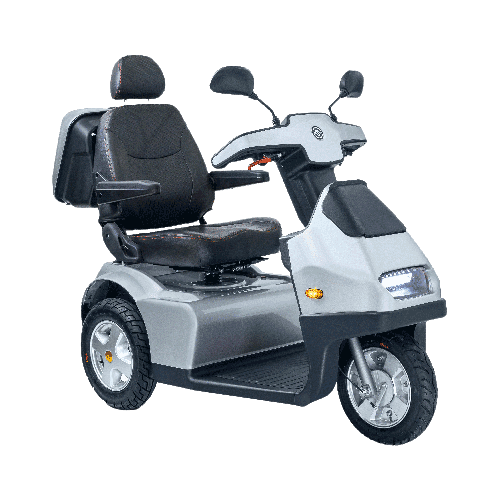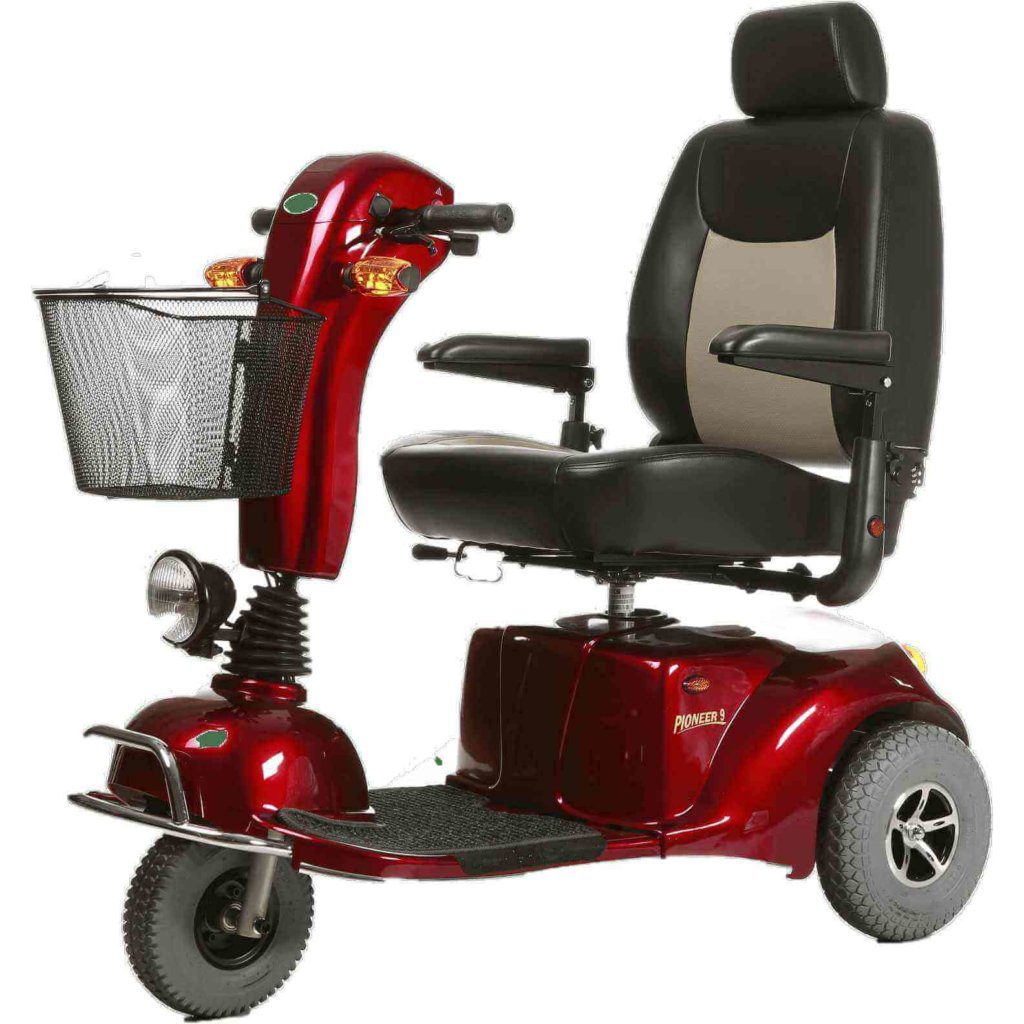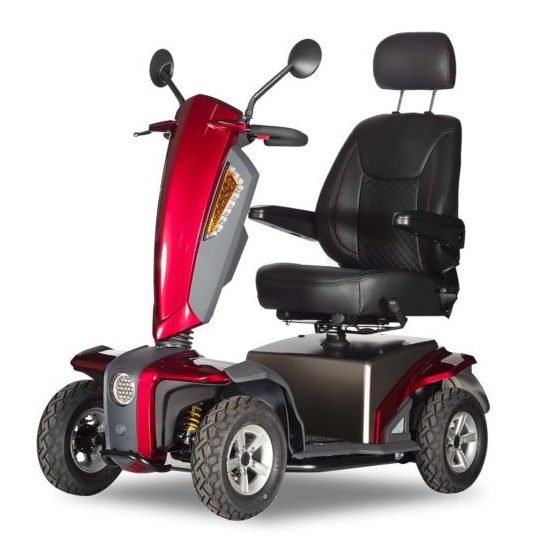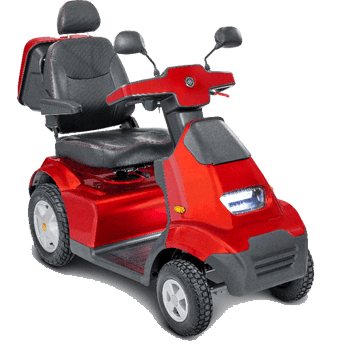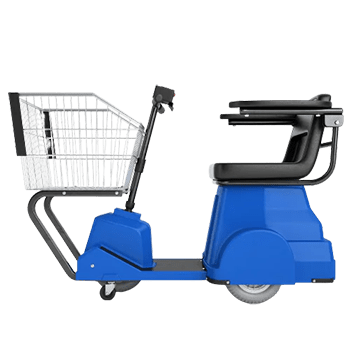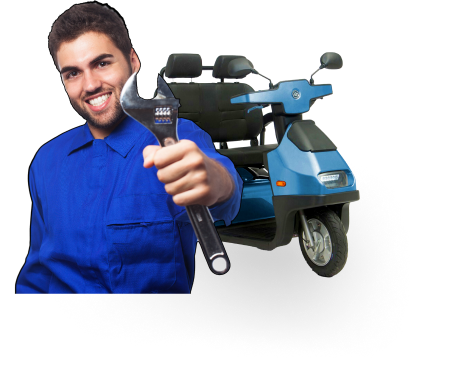Table of Contents
Introduction
Navigating steep hills can be a challenge, especially for those relying on mobility scooters for daily transportation. One question often arises: can mobility scooters handle steep climbs? The answer is yes, the right kinds of powerful mobility scooters can handle hills with ease.
However, it isn’t quite as simple as a ‘yes’ or ‘no’ but depends on a variety of factors. This comprehensive guide explores the capability of mobility scooters to handle steep inclines and offers insight into choosing the right scooter for your needs.
KEY TAKEAWAYS
- Incline rating and motor power impact scooter’s hill navigation capability.
- Understanding incline measurements (degrees, percentage) is crucial.
- Scooter incline limits typically range between 6-12 degrees.
- Tire grip, torque, and motor power influence scooter’s performance on inclines.
- Avoid navigating steeper inclines than recommended to prevent accidents and scooter damage.
- Surfaces like tarmac and gravel affect scooter’s grip and torque.
- Always follow manufacturer’s guidelines for safe scooter usage.
Top Mobility Scooters for Steep Hills
Understanding Mobility Scooters Incline Rating
When choosing a mobility scooter, one important specification to consider is the incline rating. This rating represents the maximum angle at which the scooter’s motor can push it up an incline while ensuring that all the wheels remain in contact with the ground. Understanding the incline rating is particularly vital for individuals residing in hilly environments or those who frequently encounter ramps. In this section, we will delve into the concept of incline rating and its significance when selecting a mobility scooter.
What is Incline Rating?

The incline rating tells you how steep a hill a mobility scooter can go up without tipping over or getting stuck. It’s a way of showing how good the scooter is at climbing hills. It’s usually shown as a degree (like 0°) or a percentage (like 0%).
Significance of Incline Rating
The incline rating plays an important role in determining the scooter’s suitability for specific environments and tasks. For individuals living in hilly areas, such as neighborhoods with steep inclines, understanding the incline rating becomes essential. It allows them to choose a scooter that can effortlessly navigate their surroundings without the risk of slippage or instability.
The incline rating is equally important for individuals who frequently encounter ramps, such as those found in buildings, parking lots, or public spaces. Whether it’s a wheelchair ramp, a ramped sidewalk, or driveways, having a scooter with an adequate incline rating ensures safe and comfortable maneuverability, allowing users to access various locations with ease.
Can mobility scooters go up hills?
Yes, properly equipped and appropriately designed mobility scooters can go uphill terrains. However, there are certain factors that one must bear in mind when operating a mobility scooter on inclined surfaces.
Firstly, it’s important to note that a mobility scooter, like any motor-powered vehicle, will generally slow down when ascending an incline. This is due to the increased load on the scooter’s motor, which has to work harder to overcome the effects of gravity. So, while a mobility scooter may be perfectly safe and capable of climbing a hill, the user may notice a reduction in speed as compared to travel on a flat surface. This is perfectly normal and is a sign that the scooter’s motor and control systems are working as they should to maintain safe and steady progress uphill.
Next, let’s touch on the subject of measuring inclines. Inclines can be measured in degrees or as a percentage, and this can sometimes cause confusion. Not all types mobility scooters, like folding mobility scooters, are designed to manage steep inclines due to their lightweight and compact nature. This is true for both manual and auto folding mobility scooters, which usually focus on being easy to move around rather than going up steep hills. So it’s important to choose a mobility scooter suited for hills if consistent uphill travel is anticipated. The degree measurement refers to the angle of the incline with respect to flat ground. On the other hand, percentage measurement, also known as the maximum gradient for mobility scooters, is a ratio of the rise (vertical climb) to the run (horizontal distance). A 100% gradient would correspond to a 45-degree angle. It’s important to understand what measurement is being referred to when considering a scooter’s capabilities.
| Degree of Incline | Percentage (Gradient) |
| 0 | 0% |
| 5 | 8.70% |
| 10 | 17.60% |
| 15 | 26.80% |
| 20 | 36.40% |
| 25 | 46.60% |
| 30 | 57.70% |
| 35 | 70% |
| 40 | 83.90% |
| 45 | 100% |
This is essential to understand because manufacturers may use either degrees or percentages to specify the maximum safe incline for their mobility scooters. Always ensure you are clear on which measurement is being used. If you’re unsure, consider reaching out to the manufacturer or a trusted dealer for clarification. Knowing the capabilities of your scooter and the steepness of the hills you plan to navigate can help you use your scooter safely and efficiently.
So while a mobility scooter can indeed go uphill, the user should be mindful of the change in speed, understand the incline measurements, and ensure the specific incline is within the scooter’s capabilities.
Navigating Downhill with Mobility Scooters

Just as important as climbing uphill, the ability for heavy duty all terrain mobility scooters to safely navigate downhill terrains is essential. This involves a combination of controlled speed, balance, and most importantly, reliable braking mechanisms.
When moving downhill, the scooter’s weight and gravity work together, which could potentially increase the speed. A good scooter should have an excellent braking system to counteract this and ensure a safe descent. Regenerative brakes, often found in high-quality mobility scooters, are particularly beneficial as they provide controlled braking while also feeding energy back into the scooter’s battery.
However, safe navigation downhill isn’t solely dependent on the braking system. The scooter’s overall stability plays a significant role, especially on steep descents. A scooter with a low center of gravity and wide wheelbase will be more stable and less likely to tip over when traveling downhill.
What is the maximum slope for a mobility scooter?
The maximum slope or incline that a mobility scooter can handle varies depending on the type of scooter, from 6 degrees to 12 degrees. Here are the maximum incline rating ranges for different types of scooters:
| Scooter Type | Maximum Incline Rating Range |
| Travel Scooter | 6° to 8° |
| Full-Size Scooter | 6° to 12° |
| Heavy-Duty Scooter | 6° to 12° |
| All-Terrain Scooter | 10° to 12° |
Factors Affecting Mobility Scooters’ Performance on Steep Inclines

A multitude of factors impact a mobility scooter’s performance on inclines. The power of the motor, the scooter’s weight, the type and size of the tires, the balance and stability of the design, and the weight of the rider all play critical roles.
A strong, high-torque motor is necessary for ascents, while a lightweight scooter can reduce the strain on the motor. Larger, well-gripped tires enhance traction, and a stable, well-balanced design ensures the scooter remains upright.
Importance of Tire Grip and Torque

The scooter’s tire grip is another essential factor in both uphill and downhill navigation. The grip is determined by several factors including tire width, diameter, and tread.
Wider tires tend to provide better grip because they have a larger contact area with the ground. This means they can distribute the scooter’s weight over a wider area, which can provide better traction, especially on loose or slippery surfaces.
Larger diameter tires often perform better on rough or uneven terrain because they can ‘roll over’ obstacles more easily. Larger tires also usually have a larger contact area which can provide improved traction.
The design on the tires, called the tread pattern, plays a big role in how well the tires grip or hold onto the road. Tires with deeper lines, or grooves, are usually better at gripping, especially when it’s wet or muddy. These deep grooves help move water away from where the tire touches the ground, making it less likely for the tires to slip.
The scooter’s torque, or its turning power, is super important when it comes to dealing with slopes. When you’re going uphill, you need good torque to help push the scooter upwards against the pull of gravity. On the other hand, when you’re going downhill, the torque helps to control the speed of the scooter and stops it from zooming down too quickly. So, a scooter with strong torque will usually do better on steep slopes, whether it’s going up or down.
How to Choose the Right Mobility Scooter for Steep Hills
Choosing the best mobility scooter for steep hills can feel overwhelming. First, consider the incline rating. This specification indicates the maximum angle the scooter can ascend while keeping all wheels grounded. Models designed for off-road or heavy-duty use often have higher incline ratings.
Battery life and motor power are also key. A robust motor and a long-lasting battery ensure that the scooter can maintain its performance on steep inclines.
Best Electric Mobility Scooters for Climbing Hills
Riding up steep hills on a mobility scooter can be tough. But, it’s not a problem with the Afikim Afiscooter S4. The S4 could be the best mobility scooter for hills. This scooter is made with power and control in mind, and it’s perfect for hilly rides. Its best feature is its strong torque – this is what gives it the strength to climb up steep slopes easily.
The Afiscooter S4 lets you pick the speed of your motor based on your needs. The standard 9.3 mph motor is great for most terrains. But, if you often need to go up steep hills, you might prefer the 7 mph motor. It’s a bit slower, but it gives you more torque, meaning more power for climbing hills. If you like speed and mostly ride on flat ground, there’s also an 11 mph motor. Just remember, the faster the speed, the less hill-climbing power it has.
These Afiscooter S models can safely go up or down slopes with a mobility scooter maximum gradient of 11° to 18°, depending on the model you choose. This means they can handle both outdoor hills and indoor ramps or slopes. Just make sure the slope you’re about to go up or down isn’t steeper than what your scooter is rated for, to keep safe.
Handling Head-On and Side Inclines
The Afikim Afiscooter S4 is really good at dealing with hills and slopes. It doesn’t lose power or control when going up or down a hill. This is great for people who have to ride on hilly or ramp-like surfaces.

The Afiscooter S4 is also great on side hills because it’s wide and well-balanced. This makes it hard to tip over when going on slopes that lean to the side. So, you can feel safe and confident while riding it.
The diagram on the right shows how the Afiscooter S4’s stability features come into play when dealing with a side incline, reducing the risk of tipping.
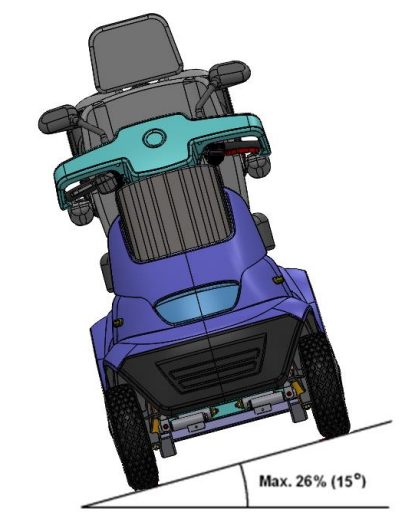
Real-world Professional Assessment
Our team at Heavy Duty Mobility recently got hands-on with the Afiscooter S4, putting its touted incline capabilities to the ultimate test. This model, known for its torque-heavy 7 mph motor, is designed not for breakneck speed, but for confidently navigating hilly terrains.
The scooter tackled a steep incline in our warehouse area with surprising ease. The motor’s rhythm remained steady and unstrained, reflecting a powerful, torque-optimized performance. It climbed the slope steadily, affirming the manufacturer’s claim that this model can handle inclines ranging from 11° to 18°. However, while its incline performance was impressive, those seeking a fast, flat-surface ride might find the pace a bit leisurely.
Beyond its incline capabilities, we inspected the Afiscooter S4’s overall design and user experience. Its robust build, comfortable seating, and user-friendly handlebars reflect thoughtful design, but the slower pace could be a potential drawback for some speed-seeking users. Despite this, we believe the balance between comfort and control is well-maintained.
The Afiscooter S4 certainly delivers on its promise to conquer inclines, while also offering a comfortable, controlled ride. For those prioritizing incline performance and comfort over high speed, this model might be a perfect match. Do explore our comprehensive reviews of similar models for a broader perspective before making your purchase decision.
If you are looking for a mobility scooter that can handle hills, the Afikim Afiscooter S3 is a great choice. Like its big brother, the S4, it’s powerful and can handle all kinds of paths, but it’s a smaller 3-wheel model. The secret to climbing steep hills easily is its power, also known as torque.
The S3 has different motor options. The basic one goes 9.3 mph and has enough power for most paths. But if you live where there are a lot of steep hills, you might want the 7 mph motor. It’s a bit slower, but it has more power for climbing. If you live where it’s flat and you like speed, go for the 11 mph motor.
This mobility scooter max gradient is from 11° to 18°, depending on which model you choose. It’s good for outdoor hills or indoor ramps. Just remember, always make sure the hill you’re about to go up or down is safe for your scooter’s model.
Handling Head-On and Side Inclines
The Afikim Afiscooter S3 is built to handle both steep hills and sloping surfaces without any problems. It has a strong motor and a dependable control system that make it easy to go up and down inclines. This is really helpful for people who live in hilly areas or need to travel on slopes often.

Just like the S4, Afikim Afiscooter S3 is made to be stable and safe when going on sideways slopes. Its wide distance between the wheels and low center of gravity help distribute the weight evenly. This means there’s less chance of it tipping over, even when traveling on slopes that go to the side.
The diagram on the right shows how the Afiscooter S4’s stability features come into play when dealing with a side incline, reducing the risk of tipping.

Real-world Professional Assessment
At Heavy Duty Mobility, we’ve recently put the Afiscooter S3 to the test, with a particular focus on its performance on inclines. Don’t be fooled by its compact, chic exterior – this scooter houses a potent power system designed to handle challenging terrains with ease.
During our rigorous evaluation, we directed the Afiscooter S3 towards the steepest slope in our testing facility. With its 7 mph motor, the scooter demonstrated that it prioritizes superior hill-climbing over sprinting on flat terrains. Despite the relatively modest speed, the ascent was stable and consistent, testifying to the scooter’s impressive torque and hill-handling prowess.
Simultaneously, the Afiscooter S3 provided a remarkable sense of control and safety. Its large pneumatic tires offered secure grip even as the terrain became steeper, making it feel less like a vehicle and more like a reliable partner on the journey.
However, the Afiscooter S3 does come with a heavier price tag compared to other mobility scooters. While its robust performance and superior hill-climbing capabilities do justify the cost, this might be a sticking point for budget-conscious shoppers. Remember, a good scooter is an investment, so it’s important to weigh the cost against the benefits and your specific needs.
The EV Rider Vita Xpress is a mobility scooter designed to handle steep inclines with power and confidence. It’s made to provide a comfortable and high-performing experience, allowing users to navigate challenging terrains effortlessly.
One of the Vita Xpress’ standout features is its powerful performance. It’s equipped with a strong 750-watt 4-pole motor and a responsive Rhino2-120A controller. This combination enables smooth and reliable navigation on steep hills, easily tackling inclines up with a mobility scooter incline rating of 10 degrees (an 18% gradient). Whether you encounter steep ramps or hilly paths, the Vita Xpress is up to the challenge.
Stability is crucial when choosing a mobility scooter, and the Vita Xpress excels in this aspect. It has a well-balanced design, measuring 55″ in length, 26″ in width, and 53″ in height. With a ground clearance of 3″, it offers a great balance of stability and freedom of movement. Whether you’re traversing challenging terrains or moving on flat surfaces, this scooter ensures a steady and reliable ride.
The Vita Xpress is suitable for a wide range of users, with a weight capacity of 350 lbs. It can reach a maximum speed of 7.5 mph and travel up to 25 miles on a single charge. This combination of speed and endurance makes it an excellent choice for tackling steep hills and longer journeys.
Handling Head-On and Side Inclines
The EV Rider VitaXpress is great at handling both steep slopes and sideways inclines. It has a strong motor that gives it enough power to climb up steep hills, and the control system helps it go down slopes safely and smoothly.

The VitaXpress scooter is designed to stay stable on sideways slopes. Its wide wheelbase and strong construction help keep it from tipping over. This is important when riding on paths that go sideways, so you can have a safe and secure ride.
The diagram on the right demonstrates the VitaXpress’s ability to handle side inclines safely due to its stable design.

Real-world Professional Assessment
We at Heavy Duty Mobility had the unique opportunity to assess the EV Rider Vita Xpress’ capabilities, with our primary focus being its performance on inclines. Side slopes often pose a challenge for many mobility scooters, but the Vita Xpress handled them with unexpected ease.
Its broad wheelbase and solid build provided an impressive grip and balance on side inclines. The mobility scooter hill climber held steady, refusing to wobble or tip over, almost defiantly telling the slope, “You can tilt all you want, but I’m not budging.” This unwavering stability proved the Vita Xpress to be not just any mobility scooter, but a reliable partner on challenging terrains.
Upon riding the VitaXpress, it became clear that this scooter was engineered for endurance. Powered by dual 12V / 80Ah batteries and a 5 Amp off-board charger, it embodied quiet yet potent stamina, ready for extended adventures on diverse terrains.
But there’s a bit of a downside. The scooter’s ground clearance is only 3 inches. While this isn’t a deal-breaker, it could limit your ride over certain bumps or uneven surfaces. You might want to keep this in mind, especially if you often traverse rough terrains.
The Merits Pioneer 9 is a mobility scooter that excels at handling steep inclines and challenging terrains. Its strong motor and well-designed features make it easy to conquer uphill paths, ramps, and tricky pathways with confidence.
What sets the Pioneer 9 apart is its powerful DC 24v, 400w motor. It gives the scooter the necessary power to reach a maximum speed of 8mph, ensuring a smooth and effortless ride uphill. Whether you’re exploring your local area or venturing into nature, this scooter provides a seamless experience.
The Pioneer 9 doesn’t just focus on speed and power—it also boasts a mobility scooter maximum incline of 12 degrees (or a 21% incline). This means it can handle challenging terrains that might be difficult for other models. With this mobility scooter for hills, you have the freedom to go off the usual flat paths and explore more adventurous routes.
Safety is a top priority, especially when dealing with steep inclines. The Pioneer 9 addresses this concern with its 12.5″ flat-free rear wheels and 10″ front pneumatic tire. These provide excellent traction, even on uneven surfaces. When you need to slow down or stop, the scooter’s intelligent, regenerative, and electromagnetic brakes ensure reliable and effective stopping power.
Handling Head-On and Side Inclines
The Merits Pioneer 9 is really good at going up and down both steep hills and sideways slopes. Its powerful motor and efficient control system make it great at climbing uphill. This makes it a trustworthy option for people who live in hilly areas or need to travel on slopes often.

The Merits Pioneer 9 is also designed to stay stable when riding on sideways slopes. It has a wide wheelbase and a strong build that helps it maintain balance on paths that slant sideways. This ensures a safe and secure ride for users.
The diagram on the right shows how the Pioneer 9 manages a side incline, emphasizing its stability when the path slants sideways.
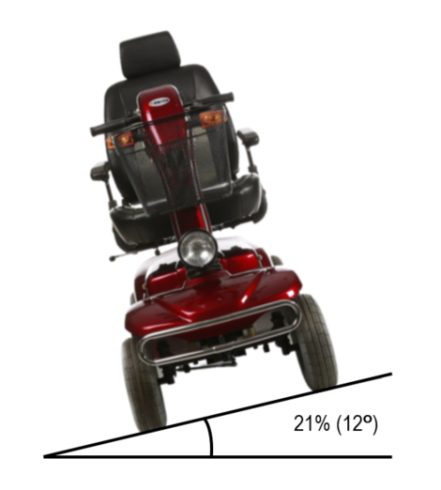
Real-world Professional Assessment
Recently, our Heavy Duty Mobility team had the opportunity to put the Merits Pioneer 9 to the test. Equipped with two 12V/Group 24 batteries promising a 32-mile journey on a single charge, the Pioneer 9 signifies the epitome of endurance and mobility freedom. This scooter’s robust construction was immediately evident, designed to comfortably bear up to 500 lbs, it immediately conveyed its readiness to serve as a steadfast partner across all terrains.
Our main area of testing was the Pioneer 9’s performance on inclines. Here, the scooter truly shone. Its potent motor, backed by an efficient control system, handled steep ascents with an ease that would make it an ideal choice for users in hilly locales. This mobility scooter took on challenging inclines without hesitation, dismissing them as mere bumps in the road.
To conclude, the Merits Pioneer 9 is more than a mobility scooter for hills – it’s a dependable partner for any mobility journey. Unfazed by inclines and harsh terrains alike, this scooter is committed to delivering steadfast performance and superior handling. After our hands-on testing, we confidently recommend the Pioneer 9 as a trusty companion, ready to face all challenges head-on.
But before you get too excited, it’s fair to mention one tiny drawback we noticed – the foam-filled tires. These tires are not as comfy as the pneumatic (air-filled) ones, which could be a bit of a bummer on long rides. So, while the scooter is a champ on hills, you might feel the bumps a bit more.
The Merits Pioneer 10 is a hill climber mobility scooter that excels at navigating steep inclines, ramps, and hilly terrains. It’s specifically designed to handle uphill challenges with ease. Whether it’s a gentle slope or a tough hill, the Pioneer 10 is ready to conquer it.
The Pioneer 10 offers a good balance of speed and range. It can travel at a maximum speed of 6 mph and cover an impressive distance of up to 32 miles on a single charge. However, its standout feature is its ability to handle steep inclines. With a gradient capacity of up to 12 degrees (21%), it can easily tackle hills that may be difficult for other scooters.
At the core of the Pioneer 10 is its powerful DC 24v, 400w motor, which works in harmony with the Dynamic Rhino 160A controller. This combination ensures a smooth and responsive performance, even when facing uphill paths.
Stability is a crucial factor when dealing with challenging terrains, and the Pioneer 10 delivers on this front. With its dimensions of 55″ in length, 27″ in width, and 47″ in height, it provides a safe and secure ride. A ground clearance of 4″ allows you to navigate uneven surfaces comfortably, while the 62″ turning radius makes maneuvering easy, even in tight spaces.
Handling Head-On and Side Inclines
The Merits Pioneer 10 is great at handling both steep hills and sideways slopes. Its strong motor and responsive control system make it easy to climb uphill without any difficulty. This ensures a smooth and comfortable ride for the users.

The Pioneer 10 is designed to stay stable when riding on sideways slopes. It has a wide wheelbase and a strong build that helps it maintain balance on paths that slant sideways. This ensures a safe and secure ride for users.
The diagram on the right displays the Pioneer 10’s ability to navigate a side incline safely, showcasing its stability features.

Real-world Professional Assessment
Our team at Heavy Duty Mobility recently put the Merits Pioneer 10 to the test. The day started with a challenge: a daunting incline set to examine the robustness of the 12.5″ flat-free front casters and drive wheels. As we embarked on the uphill trek, the Pioneer 10, powered by a formidable 500 lbs. carrying capacity, showcased unmatched stability and confidence, proving that its design was indeed meant to confront steep terrains.
The scooter’s downhill prowess was equally commendable. A slight tug on the intelligent, regenerative, electromagnetic brakes was all it took for the Pioneer 10 to halt safely. This remarkable control system instilled a sense of security during descent, demonstrating its ability to handle both upward and downward inclines with ease.
Shifting focus from the inclines, the Pioneer 10 didn’t compromise on comfort. The 22″ wide seat, paired with a 20″ depth and a 22″ high backrest, ensured a spacious and inviting seating arrangement. The seat’s adjustable height feature further enhanced rider comfort, providing a customized riding experience.
But the real star of the show was the Pioneer 10’s endurance. Equipped with two 12V/Group 24(70AH-80AH) batteries and a 6A off-board charger, this mobility scooter for steep hills maintained its performance throughout the day, even in demanding uphill terrains. Yet, there was one minor hiccup we found – its ground clearance is only 4″. So, it might struggle with bigger bumps or obstacles on the road. Regardless, the Merits Pioneer 10 still proves itself to be a reliable companion in any mobility journey. Stay tuned for more in-depth reviews on our platform.
Reviews of the Best Electric Mobility Scooters for Hills
| Model | Motor Power (Wattage) | Description |
| Afikim Afiscooter S4 All Terrain | 1400 W | Its powerful motor helps navigate through different terrains with ease, including steep hills. |
| Afikim Afiscooter S3 | 1400 W | Shares the same power as the S4 model, capable of handling various terrains and inclines effortlessly. |
| EV Rider VitaXpress | 750 W | Its motor power provides a balance between performance and energy efficiency, suitable for moderate inclines. |
| Merits Pioneer 9 | 400 W | While less powerful, this model is designed for moderate terrains and gentle slopes. |
| Merits Pioneer 10 | 400 W | Shares the same power as the Pioneer 9, suitable for moderate terrains and slopes. |
What is the best mobility scooter for steep hills?
The best mobility scooter for steep hills is the Afiscooter S4 All Terrain Tires. It is specifically designed with a strong emphasis on power and control, making it ideal for navigating challenging inclines. With its customizable motor speed options and impressive torque, the Afiscooter S4 offers the perfect combination of power and versatility for conquering steep slopes with ease and confidence.
Risks of Using a Mobility Scooter on a Steeper Incline Than Allowed

Navigating steeper inclines than recommended with a mobility scooter can pose several risks, including:
1. Tipping Over
The biggest danger with mobility scooters is tipping over. The scooter’s design aims to keep it stable and balanced on slopes up to a certain angle. If you go beyond that angle, the scooter can lose its balance and tip over, causing severe injuries.
2. Motor Overload
When going up steep slopes, the scooter’s motor needs more power. If the slope is too steep for the scooter’s design, the motor can get overloaded, causing it to overheat or even stop working. This can be dangerous as it could lead to a sudden stop, possibly in a dangerous place. It can also be expensive to fix or replace the motor.
3. Loss of Control
When going downhill on steep slopes, the scooter’s brakes might not be strong enough to stop it safely if the slope is too steep. This can cause the scooter to go down too quickly and make it difficult to control. It increases the risk of accidents happening.
4. Battery Drain
Going up steeper slopes uses up more power from the scooter’s battery. This means the battery can run out faster, especially if the slope is really steep. If the battery dies before reaching the intended destination, the user could end up stranded and unable to continue their journey.
5. Structural Stress
Using a scooter on slopes that are too steep for it can cause extra strain on the scooter’s structure. This can make the scooter wear out more quickly and may even make it break down sooner than expected.
For these reasons, it’s important to adhere to the manufacturer’s guidelines regarding maximum incline capacity for safe and efficient operation of your mobility scooter.
Typical Use Cases of Inclines
Mobility scooters are made to help people move around in different places, some of which have slopes. Here are a few situations where a scooter might come across inclines:
1. Driveways

The steepness of driveways can be different depending on how the house is built. Some driveways might be flat, while others could be quite steep.
2. Roads

In hilly areas, roads and sidewalks often have slight slopes. Even though these slopes may be small, they can accumulate and affect your journey.
3. Hills

In rural or hilly neighborhoods, users may need to navigate steep hills on a regular basis.
4. Ramps

In cities and towns, you’ll often come across ramps in places like shopping centers, office buildings, and hospitals. These ramps are built to make it easier for people using wheelchairs or mobility scooters to get around.
5. Trails
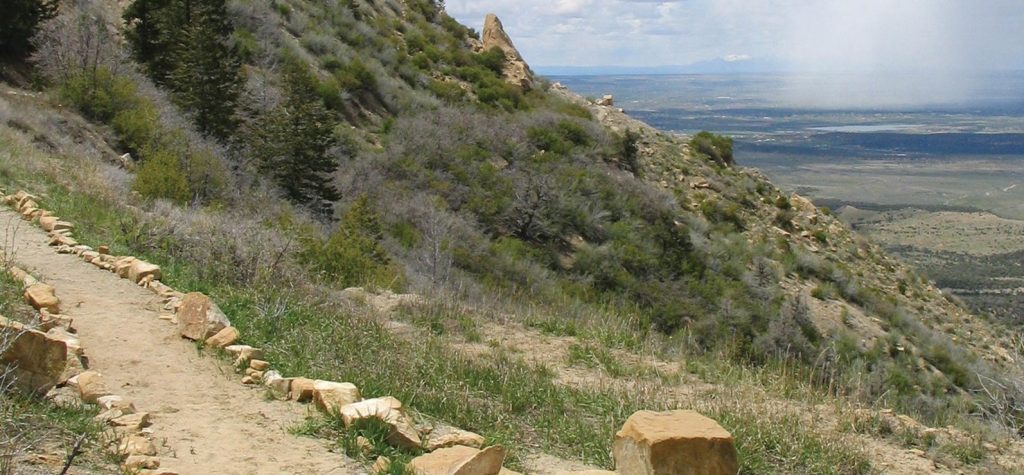
Some scooter users might enjoy going off-road and exploring nature trails. These trails can have different slopes and can be quite tough for a scooter to handle.
What to Do If Stuck on an Incline
1. Stuck Uphill
If your scooter gets stuck while going uphill and won’t move, don’t try to force it. The scooter might not have enough power or grip to climb the slope. It’s better to look for another route that is less steep, if you can. If that’s not possible, it’s a good idea to ask for help to get off the scooter safely and move it to a flat surface.
2. Stuck Downhill/Loses Control
If your scooter starts to lose control while going downhill, stay calm. If your scooter has an emergency brake, use it right away. If there is no emergency brake, steer the scooter towards a flat or upward surface to slow it down naturally. Remember, in situations like this, it’s important to ask for help.
Impact of Different Surfaces on Grip and Torque
Tarmac

This type of surface is usually smooth and provides good traction for the scooter’s wheels. The wheels can grip well on tarmac, which helps the scooter move efficiently. As a result, scooters usually work well on tarmac inclines, as long as the incline isn’t too steep.
Loose Gravel/Soil
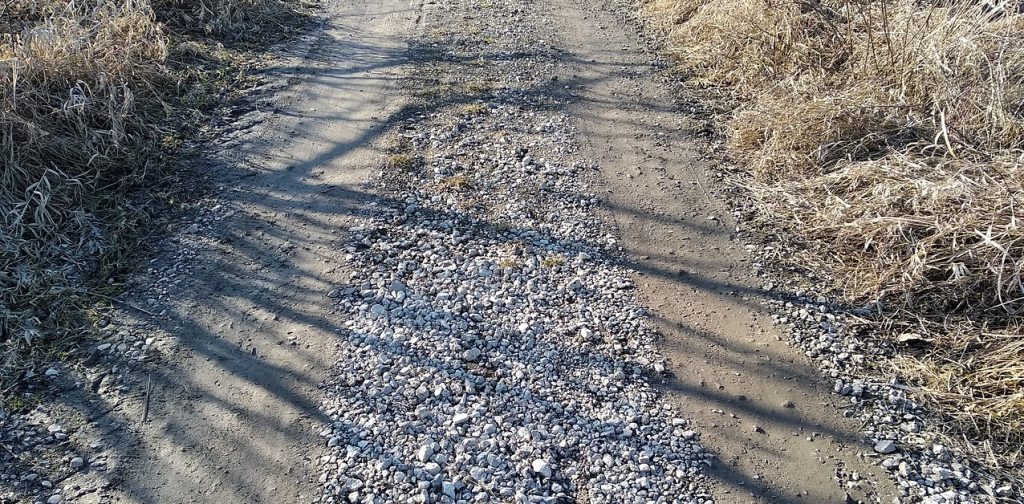
On the contrary, loose gravel or soil can make it difficult for mobility scooters. The small particles can move around when the scooter goes over them, reducing the grip. This makes it harder for the scooter to climb uphill. Also, loose surfaces can be unpredictable, and the wheels might sink in or slide, so it’s important to be extra cautious.
All mobility scooters have their limits. Always check the manufacturer’s guidelines regarding the maximum safe incline and the type of surfaces your scooter can handle. If in doubt, it’s better to be safe and avoid a potentially risky situation.
Mobility Scooter Usage and Safety Tips
Safety should always be your top priority, especially when you’re tackling steep hills. To make sure your ride is both safe and fun, check out these important guidelines and remember to stay in control no matter what.
1. Follow Manufacturer's Guidelines
Each mobility scooter is designed with specific slope gradients and weight limits in mind. It is imperative to strictly adhere to the manufacturer’s guidelines to prevent accidents or damage to the scooter. Pay attention to the recommended maximum incline angles and weight capacities, as exceeding these limits can compromise the stability and maneuverability of the scooter.
2. Regular Maintenance
Maintaining your mobility scooter in good working condition is essential for safe operation. Regularly check the brakes, tires, and overall mechanical components to ensure they are functioning properly. Keep the scooter’s battery charged and check for any signs of wear or damage. Following the manufacturer’s maintenance schedule will help prevent unexpected issues and ensure optimal performance.
3. Be Aware of Road Conditions
Before you start your trip, check the road conditions and be aware of any hills or dangers ahead. Watch out for uneven surfaces, loose gravel, or wet areas, as they can affect how well your scooter grips the ground and stays stable. Adjust your speed and how you drive based on these conditions. When going uphill, be especially careful to stay in control.
4. Cautious Driving
To stay safe on steep hills, drive carefully and slowly. Give yourself enough time to react to anything unexpected. Avoid suddenly speeding up or stopping, as it can make the scooter unstable. Use the controls gently and smoothly, keeping a comfortable pace throughout your trip.
5. Utilize Assistive Features
Most mobility scooters have safety features to help protect you. These can include advanced brakes, anti-tip devices, and stability-enhancing technologies. Take the time to understand how these features work and use them to stay safe, especially when going up or down steep hills.
6. Be Mindful of Weight Distribution
When going up steep hills, it’s important to distribute your weight evenly on the scooter. Avoid leaning too much in any direction, whether forward or backward. This helps keep the scooter stable and prevents it from tipping over or losing control on the incline.
7. Plan and Communicate
Plan your routes carefully, considering any steep inclines or challenging terrains you may encounter. If possible, inform a trusted friend or family member about your intended route and estimated time of return. This adds an extra layer of safety and ensures that someone is aware of your whereabouts in case of an emergency.
Prioritize caution, adhere to guidelines, and maintain your scooter to ensure a safe and pleasurable mobility experience
Conclusion
As we conclude our in-depth guide on the best mobility scooters for steep hills, we genuinely hope that the information and tips we’ve shared will go a long way in enhancing your scooter experiences. Remember, the journey up and down steep inclines doesn’t have to be scary; it’s all about understanding your scooter, respecting its capabilities, and always prioritizing safety.
From choosing the right mobility scooter, and understanding its specific features, to safe usage and maintenance practices, it’s all about making informed decisions. This way, you’ll be prepared to tackle any hill confidently and safely.
So, plan your routes, let someone know where you’re going, and ensure your scooter is in its best shape before you venture out. You have the freedom to explore, and we believe that with these guidelines, steep hills will no longer be obstacles but milestones to conquer.
Enjoy your rides, explore new terrains, and don’t forget to make safety your constant companion. After all, your mobility scooter is your key to freedom and independence. Here’s to safe and enjoyable scooting adventures on those challenging hills.
Steep Hills Won’t Keep You Home with these Powerful Electric Mobility Scooters
Check out our blog on off road mobility scooters top picks by clicking the green button below
Sources for Mentioned Features and Specifications
-
- Afiscooter (manufacturer of S3 and S4) full S3 product page and full S4 product page, full S3 and S4 specifications sheet taken from manufacturer website, afiscooters.com.
- EV Rider (manufacturer of Vita Xpress) full Vita Xpress product page and full Vita Xpress specifications sheet, taken from manufacturer website, evrider.com.
- Merits (manufacturer of Pioneer 9 and Pioneer 10) full Pioneer 9 product page, full Pioneer 10 product page, full Pioneer 9 and Pioneer 10 specifications sheet, taken from manufacturer website, meritsusa.com.

Raphael Perlmann
Raphael possesses an extensive expertise in mobility scooters, with more than four years of experience in the industry. He is passionate about assisting customers in making informed decisions by imparting his profound knowledge of various models and alternatives. Raphael is dedicated to providing exceptional customer service and maintaining integrity, ensuring a stress-free scooter purchasing experience. He is consistently prepared to address any inquiries or resolve any issues. Rely on Raphael for valuable guidance and dependable assistance for all your mobility requirements.

